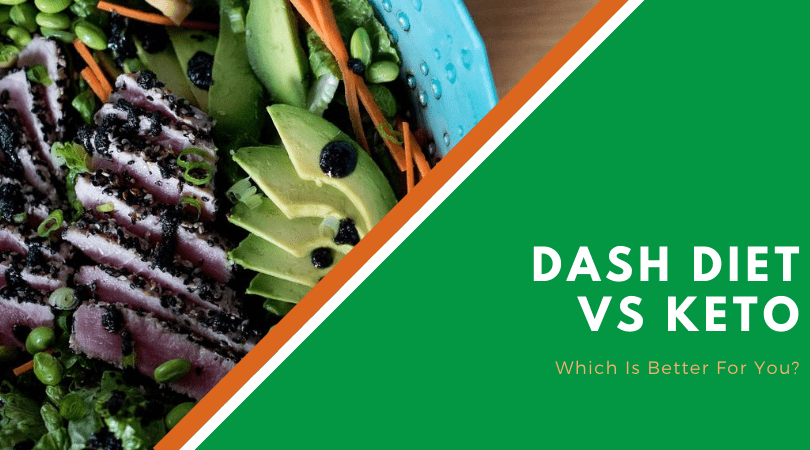Have you thought about going on a diet? Then you must have been stuck at one point because there are so many of them to choose from.
Keto, DASH, paleo, vegan, low-fat… Just to name a few. Perhaps you want to lose weight, boost your health, or hope to recover from a health condition.
It’s clear that diet plays a massive role in your physical and mental well-being, but choosing the right one can be challenging. In today’s article, we’ll be looking at the keto and DASH diets.
Which one should you go for to help you reach your goals, and are there any perks or downsides to each of them? This article will be your guide to help you understand these two diets better and decide if any of them is good for you.

Defining DASH vs. Keto Diet
DASH is an acronym for Dietary Approaches to Stop Hypertension. It was developed following research projects sponsored by the National Institutes of Health (NIH). The research was aimed at discovering dietary interventions that could help in the prevention and cure of hypertension.
Keto diet refers to the ketogenic diet, which is high fat and low carb. It’s so named because it’s a diet that leads to increased production of ketones in the blood. It puts the body in a metabolic state known as ketosis.
While the DASH diet was developed to specifically deal with high blood pressure (hypertension), the ketogenic diet is more geared towards weight loss and maintaining healthy body and brain function.
So, when you’re choosing which of these two to go for, you need to ask yourself what your health needs are. If you have problems with your blood pressure or cardiovascular health, DASH can be a great option.
But, it might not work as well if what you want is to lose extra pounds. The keto diet will be better for this. Keto is also great for improving your physical and mental energy levels.
What to Eat on a Keto Diet
The keto diet is high in fats and low in carbohydrates, with moderate amounts of proteins. The main purpose of this diet is to switch your body’s energy source from carbohydrates to fats.
It works in the opposite model of a low-fat diet, and studies have shown that a keto diet is actually more effective at weight loss. Therefore, when you’re on a keto diet, you need to cut off most of the carbohydrates from your meals and add lots of healthy fats.
Some of the foods to eat on a keto diet include:
- Fatty fish such as tuna and mackerel.
- Meat including chicken, steak, red meat, etc.
- Low-carb vegetables such as tomatoes and green veggies.
- Healthy oils, for example, avocado and coconut oils.
- Unprocessed dairy products, such as cheese and butter.
- Spices, herbs, salts, and other food condiments
- Nuts and seeds.
You can eat almost anything on the keto diet, as long as it’s healthy. This is why the ketogenic diet is so popular among weight loss management enthusiasts.
It allows you to eat all of your favorite foods while losing the extra pounds! No starving or obsessive calorie counting are involved.
The only thing you have to do is keep a watch on the amount of carbohydrates that you consume, and ensure that you’re getting lots of healthy fats.

Keto Snacks
Another perk with the keto diet is that you don’t have to make do with flavorless foods in the name of avoiding fats or seeking nutrients. Most high fat and low carb foods are delicious – fish, chicken, dark chocolate! – so that’s not a concern on a keto diet.
In addition, you’ll still be able to indulge in snacks such as:
- Full-fat yogurt.
- Ice cream.
- Keto crackers.
- Green sandwich wraps.
- Hard-boiled eggs.
- Nut butter.
- Dark chocolate.
Foods to Avoid on a Keto Diet
In order to maintain ketosis, you should avoid foods that are high in carbs. These include processed sugary foods, low-fat foods, and grains, and starches.
You should also avoid alcohol, which is usually high in carbohydrates. Watch out for condiments and sauces that normally contain added sugars and unhealthy fats, which can increase your carbs intake and undermine your health.
Also, avoid huge servings of fruits, legumes, processed vegetable oils, root vegetables, and wheat-based products.
Benefits of Going on a Keto Diet
When you go on a keto diet, you can expect the following benefits:
- Increased weight loss.
- More energy during workouts and throughout the day.
- Increased mental function and focus.
- Improvement of overall health.
- Reduced blood sugar levels.
- Improved insulin sensitivity.
The keto diet is most notable for its weight loss benefits. This is because when it switches your body into ketosis, it forces it to use the stored fats as fuel.
If you keep up your keto diet for long enough, you’ll notice that stubborn fat deposits around your hips, thighs, and waist area will begin to disappear.
The keto diet has also been shown to significantly improve insulin sensitivity. By fixing insulin resistance, it aids in blood sugar regulation and prevents the accumulation of fats in the body.
Given how widespread this diet has become, there are many keto-friendly food brands in the market that can make maintaining it easier for you. A great brand is Perfect Keto, which offers a variety of ready-to-use keto snacks and supplements.
These snacks can help you curb hunger cravings so that you don’t go looking for fast foods that are high in carbs or sugar. The Perfect Keto exogenous ketones can get you past the troublesome keto flu while your body becomes fat-adapted.
They can also come in handy when you need an energy boost during your workouts.
Pros
- Easy to follow and maintain.
- Does not require starving or strict calorie restriction.
- Great for weight management.
- Lots of food choices.
- It can support an active lifestyle.
Cons
- You’ll experience the keto flu before your body adapts to ketosis.
- It causes dehydration and loss of electrolytes.
What to Eat on the DASH Diet?
With the DASH diet, the main goal is to reduce sodium intake in everyday meals. The typical daily American diet contains about 3400gms of sodium, which is way above the amount recommended for good heart health.

According to the Dietary Guidelines for Americans, you should consume less than 2300mgs of sodium per day. The American Heart Association further recommends an average of 1500mgs of sodium each day.
Since most Americans are unable to remain within the healthy limits of sodium consumption, DASH was developed to help guide them on how to maintain the recommended daily intake.
To maintain a DASH diet, you’ll need to go for low-sodium or sodium-free foods. These foods should be rich in other minerals such as magnesium, calcium, and potassium.
When you maintain a balance among these minerals, you’ll significantly reduce your risk of developing high blood pressure and other health concerns.
Foods that you can eat on a DASH diet include:
- Whole grains.
- Lean meat, fish, and poultry.
- Fats and oils.
-
Vegetables
-
Fruits
- Nuts and seeds.
-
Legumes
-
Sweets
These foods will provide your body with all the nourishment it needs while decreasing your risk of hypertension. If you already have high blood pressure, your symptoms will be significantly reduced.
If you’re consistent with your DASH diet, your blood pressure can drop several points within two weeks. This diet can cause a blood pressure drop of as much as 8-14 points, which can improve your health significantly.
Foods to Avoid on a DASH Diet
While on a DASH diet, you’ll need to avoid foods that are high in salt or added sugars. It means cutting off most processed foods.

Also, you’ll have to watch the amounts that you eat of the allowed foods. While the above DASH-friendly foods are low-sodium, taking too much can affect your diet.
For instance, you should keep your whole grain servings to 6-8 per day, while you should only have 2-3 servings of fats and oils. For vegetables, get 4-5 servings daily.
Table salt is one of the major sources of sodium in our diets, besides food sources. Therefore, you should avoid adding salt to foods that already contain enough sodium. These include grains such as rice.
Besides high-sodium foods, you should also avoid trans and saturated fats. These fats are common culprits in cardiovascular disease.
Trans fats are rampant in processed foods and baked or fried items, while saturated fats are found in dairy products.
Instead, consume monounsaturated fats, which are great for health, and which will not risk your cardiovascular health.
Benefits of the DASH Diet
The benefits of the DASH diet include:
- Lowered blood pressure.
- Improved blood vessel and heart health.
- Weight loss.
The biggest benefit of the DASH diet is that it lowers high blood pressure, thereby solving hypertension. When there’s too much salt or sodium in the body, the kidneys have a hard time drawing water from the blood.
The excess fluid leads to a spike in blood pressure. It puts a strain on both the blood vessels and the heart that has to overwork to pump blood to all organs.
Over time, your arteries will become thick in order to handle the pressure, but this only leads to hypertension. It also increases the risk of your blood vessels leaking or rapturing.
Maintaining normal sodium levels in the body through the DASH diet ensures that hypertension and the series of health consequences that follow are prevented.
Your kidney functioning will also be optimal, which means your body will be able to excrete toxins on a timely basis. This goes a long way in improving your general health.
The DASH diet can also benefit your overall wellness because you’ll be making healthy food choices while avoiding unhealthy fats.
Pros
- Lowers high blood pressure.
- Decreases the risk of diabetes, cancer, and metabolic syndrome.
- May aid in weight loss.
- Reduces the risk of heart disease.
Cons
- Requires a lot of food tracking.
- Hard to follow and maintain.
Choosing Between DASH and Keto Diets
When it comes down to it, which between these two should you choose? Like all dieting choices, it should depend on your needs. A few questions to ask yourself to help you decide are:
- What health conditions am I dealing with?
- Do I want to lose weight through my diet?
- What diet suits my lifestyle better?
- How do I want to improve my health?
- Will I be required to exercise to get positive results?
- Is this diet long or short term?
It’s clear that both DASH and keto diets will improve your health in a number of ways. But, DASH is the best option if you want to prevent or treat hypertension. On the other hand, keto will be the ideal option if you want to lose weight.
If you don’t have a lot of time to watch your sodium and fats intake, then DASH can be a bit challenging for you. Watching your servings and their salt content can be tiresome, but you can also opt for ready meal plans to help you get along.
DASH is more of a long term, lifetime diet. With keto, you can choose to use it short term to achieve your weight loss goals.
All in all, maintaining either of these healthy diet options long-term is a better option compared to the normal American diet that exposes you to a myriad of health problems.

Conclusion
The DASH diet will help you manage hypertension, while the keto diet is great for weight loss. Once you make your decision, ensure that you remain consistent.
This is because, like other diets, consistency is key to achieving the optimal results. Make use of resources such as pre-made meal plans and supplements to help you along.
If you’re getting into any of these diets with the hope to manage existing health conditions, a consultation with your physician can be helpful.

